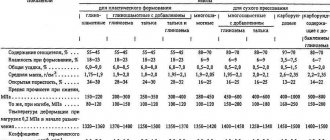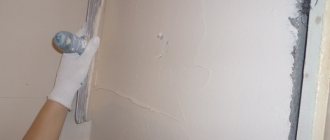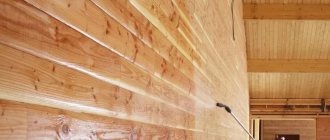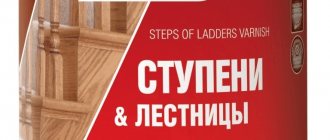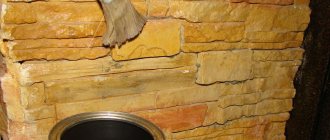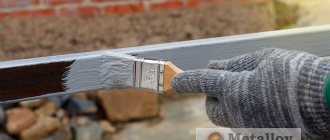Protecting wood from mold, rot and bugs is the primary task of any owner of a wooden house or log house. This question is very important if you are working with wooden products that will later be used outdoors. Homemade homemade furniture also needs protection from moisture and other negative natural factors.
Coal oil is considered the best way to impregnate wood. But it is used only for impregnation of sleepers or other objects operated in harsh conditions. For independent work, use more affordable and pleasant-smelling compositions.
Oil or wax?
Both of these substances are used to protect wood from moisture, mold, mildew, rot and bugs. Both oil and wax have been used since time immemorial and always show good results. They improve the appearance of the tree and increase its strength and service life.
Impregnating oils for woodworking have high antiseptic properties and penetrate deeply into the wood structure, making its surface elastic . They protect the wood from drying out, do not clog the pores, allowing the surface to breathe, and regulate humidity. Wood oils are harmless to humans and are considered the most environmentally friendly way to protect them, along with wax.
Of the oils most often used for self-impregnation of wood, the following can be noted:
- tung;
- teak;
- tar;
- flaxseed
Some people prefer to use oil such as sunflower to impregnate wood. However, it gives the worst effect. The reason is polyunsaturated fatty acids: there are extremely few of them in sunflower.
Waxing is the oldest way to protect wooden products from moisture penetration. Wax fills the pores of the wood and gives it a matte color. Its only drawback is the lack of “breathing” of the treated wood.
Important! It is not advisable to work with pure wax, so it is dissolved in vegetable oil, for example, linseed, plus other additives (turpentine) are included in the composition. This type of work takes quite a long time. Therefore, impregnation of wood with oil compounds is considered the best option for protecting it from moisture, rot, and mold.
Advantages and disadvantages of using oils
Without treatment, wood will not last long. Impregnation involves:
- ease of processing;
- environmental cleanliness;
- reasonable price;
- improving the aesthetics of the appearance of structures;
- the appearance of a beautiful shine;
- speed of restoration work;
- disappearance of scratches;
- extending the service life of products;
- versatility (any processing material is assumed);
- the appearance of a protective film;
- UV protection.
Along with a lot of positive qualities, there are certain disadvantages in using oil compositions, which are worth mentioning:
- there is a need for regular care;
- Grease stains may appear and will require re-processing.
Pros and cons of oil for wood processing.
Treating wood with oil-based compounds has many advantages. This:
- environmental cleanliness;
- aesthetic appearance of processed products: oiled surfaces after good polishing acquire a matte shine and become velvety to the touch;
- ease of processing;
- availability of material;
- relative cheapness;
- rapid restoration of mechanical damage. It is enough to re-treat furniture or floors/ceilings/walls and the scratches will immediately disappear.
Oil impregnation will be an ideal protection option for products made of expensive/exotic wood, houses/buildings made of logs (log houses), furniture that is exposed to moisture.
However, oil impregnation also has disadvantages:
- Surfaces are quite demanding to maintain. This applies to both furniture and floors, ceilings, and walls. They need to be impregnated every 3 to 4 months and then thoroughly polished.
- Oiled surfaces are vulnerable to grease. Its stains are clearly visible. Repeated processing removes them
Tung oil.
This is an ancient product used to protect interior wood surfaces from moisture, rot and wood-boring beetles. It can be used to impregnate floorboards, ceilings, wooden furniture, trim and even dishes.
Important! During the Tsarist reign, tung oil was used to finish especially valuable types of wood, from which unique interior items were made. This is due to its amazing ability to very quickly penetrate the surface layer of wood, maximizing its texture.
Before starting work, tung oil should be mixed. It is best to work at an air temperature of +15° C. At a lower value, the composition thickens, and its consumption increases accordingly (standard amount per square meter is 100 - 150 g). Application is done in a very thin layer with a brush. Then let the oil soak in (20 minutes), take a sponge or soft cloth and rub the residue into the wood along the grain. Excess is removed. To increase absorbency, you can dilute tung oil by 40 percent with white spirit. The product is ready for use within a day.
Important! All oily used rags are disposed of as household waste. Grease can be washed off your hands with warm soapy water.
Teak oil.
This is a universal product. It can be used to process both internal wooden surfaces (floors, ceilings, decorative items, railings, stairs, etc.) and external ones (facades, gazebos, garden furniture, decorative figures for landscape design). Ideal for processing products made of oak, mahogany, beech and other valuable wood species.
Teak oil is an environmentally friendly product. It contains tung and linseed oils, purified pine turpentine. It has nothing to do with the tree of the same name (teak).
Important! Never dilute teak oil! Before use, stir it well and/or shake the jar.
Important! The product has proven itself well in damp rooms, so it can be used to treat valuable wood in the bathroom.
Tar oil.
It is one of the most powerful natural antiseptics for DIY woodworking. It contains stump resin, pine turpentine and linseed oil. Turpentine improves the penetration of the composition deep into the wood, linseed oil retains it, preventing it from reaching the surface. The composition is actively used for treating the bottoms of boats and piers. It is also used for external impregnation of log buildings, garden houses and garden furniture.
The properties of tar oil are similar to those of teak and tung. It provides excellent protection to wooden surfaces from moisture, rot and wood-boring beetles, while giving the wood a transparent texture. The technology of work is the same as for tung and teak oils: for 1 m2 of a well-sanded surface, only 100 - 150 ml of product is required. To impregnate the walls of a log house you need from 5 to 10 liters per square meter.
The impregnated surface dries up to 7 days. The drying time depends on both the quality of the wood and the environmental conditions. When applied in one layer, drying time is only a day. Dilution is not allowed; thorough mixing is required before use!
Advice! Store tung, teak and tar oils in tightly covered containers in a cool, dry place. They are not afraid of freezing and retain all their properties in frost.
Linseed oil.
It is rightfully considered the best and cheapest means for protecting wooden surfaces. Flaxseed oil has high waterproofing qualities and is intended for treating external and internal surfaces. It can be used to impregnate wooden facades, walls, ceilings, trim, furniture and other wooden interior items; it perfectly reveals the wood texture, penetrates into the smallest cracks, preserves the wood, creating a durable water-repellent layer on its surface.
During impregnation, linseed oil thickens under the influence of environmental factors (low temperature, oxidative processes). The triglycerides it contains – linoleic and linolenic acids – actively contribute to this.
Important! Flaxseed oil dries longer than all of the above - up to three weeks, depending on the number of layers. If you add tar, wax or turpentine to it, the process can be speeded up.
How to choose the right one
Experts advise adhering to the following rules:
- Low-density species (linden and alder) prefer to deal with thick, saturated oils. Liquids can penetrate inside and not freeze there.
- For coniferous species, special impregnations are not needed. They have so much resin inside that they do not need additional protection. If absolutely necessary, you can use thick consistencies and use the waxing method.
- A distinctive feature of birch and beech is their high density. The first treatment should be with liquid products. Thick substances are suitable for repeated manipulations.
Before starting work, it is advisable to experiment on a small board.
To improve the functionality of a product, certain components can be added to it. To improve the absorbency of tung impregnation, it is enough to dilute it with white spirit in a ratio of 60% to 40%. To make linseed oil dry faster, add 30% turpentine to it and heat it a little. Sometimes wax is added to the substance. This increases the antistatic characteristics of the product and speeds up the drying process.
The choice of products is so large that you can get lost in its diversity. Improved new products are released annually. Where to buy the product? There are several options. The most acceptable way is to visit a specialized retail outlet, take a closer look at the assortment on display, and understand what it costs. If in doubt, you can consult the seller. He will not only help you choose, but will also calculate the required volume of the purchased product. You can use the services of an online store. The main thing is not to fall for the tricks of unscrupulous suppliers and not to purchase low-quality goods at a high price.
Oil impregnation for wood processing at home.
Let's look at this process using linseed oil as an example, as it is the cheapest and most accessible to the average craftsman. To work you will need a small list of useful things:
- natural hair brush, foam sponge, soft rag, rags;
- oil, a stick for stirring it;
- construction hair dryer, metal brush - to remove old coating;
- sandpaper to bring the surface to a perfectly smooth state;
- broom for removing dust from the surface;
- gloves to avoid getting dirty.
Impregnation technologies.
There are different ways to oil wood. Some people prefer smearing and further rubbing, while others prefer soaking. True, the second method is suitable only for small objects - decorative dishes, figurines. The dish, by the way, can be used (as a container for bread, salt/sugar, fruit) because it is not at all afraid of water.
Preliminary stage.
An important stage of work before impregnation will be the preliminary preparation of external/internal surfaces. For boiling, you will need to thoroughly sand the dishes or figurines . They are supposed to be freshly carved from wood and not covered with anything on top. Otherwise, you will have to remove both paint and varnish, and this is a very tedious task.
For large areas (walls, floor, ceiling) you will have to do much more:
- Rip off the old coating. This includes varnish and paint. Use a wire brush or spatula for cleaning. If the paint does not want to come off, heat it with a hair dryer. When it bubbles, lift the layer with a spatula and remove.
- Sand the surface. Use two types of sandpaper for this – coarse and fine. You can stop cleaning when you feel a smooth surface without flaws under your hand.
- Remove dust. Brush it off with a soft (Vietnamese) broom or use a regular rag. There should be no dust remaining on the surface before oil impregnation.
Coating.
The easiest way to protect wood from moisture and rot is to oil it. It's best to do this with a rag. But you can also use a brush with natural bristles. This is relevant for small areas (platbands). Impregnate internal/external walls, ceiling or floor with a soft cloth soaked in oil. This is done as follows:
- Stir the product and pour some into a separate container.
- Dampen the rag and start soaking. Apply the composition along the fibers.
- Leave the oil for 15 - 20 minutes. Then remove the residue with a rag.
- Allow the surface to dry, then repeat the treatment.
Soaking.
This method is used for small products. Pour oil into a container and place the pre-cleaned wooden product in it. The holding period is not limited. Ideally, you need to hold a plate, figurine, knife or gun handle until air bubbles stop escaping from the wood.
After this, take out the item and place it on a table covered with clean paper, tilted, so that excess oil drains off. Then take a rag and polish. Pure linseed oil without additives takes a long time to dry - up to 3 weeks. This has its own advantage - the depth of such impregnation is great, and the tree receives excellent protection from moisture, rot, and mold. If you can't wait to see the finished product, add beeswax to the linseed oil. This will significantly speed up the process.
Recipe for oil/wax composition based on linseed oil (suitable for both external and internal surfaces):
- Heat the oil until smoking.
- Pour grated wax into it.
- Stir. When the wax dissolves, pour the mixture into a jar.
- To give the mixture a pleasant aroma, add a few drops of juniper oil.
Rating of inexpensive wood oils from 400 rubles
Tikkurila VALTTI
The first place in our rating is occupied by a product from the famous Finnish concern – Tikkurila. To apply the composition you will need a long brush or roller. Designed for treating terraces. You will need to add solvent before use. The composition contains a complex of vegetable oils. For subsequent absorption, you must wait 45 minutes. Complete drying takes 8 hours if the ambient temperature is above +20°C. If necessary, the substance can be tinted in any shade. Due to auxiliary additives, the product perfectly protects structures from ultraviolet rays, moisture and fungus for two years. Afterwards you will need to restore the layer.
Cost for 0.9 l – 930 rubles.
Tikkurila VALTTI oil
Advantages:
- numerous positive reviews;
- tinting possible;
- wood breathes;
- time-tested manufacturer;
- does not allow the wood to “dry out”;
- protection against ultraviolet rays, moisture and fungi.
Flaws:
- takes a long time to dry.
Pinotex WOOD&TERRACE OIL colorless
This composition will protect wooden structures from excessive humidity, significant temperature changes, severe frosts, snowfall, rain and ultraviolet rays. Improves the moisture-repellent properties of products. The substance applies well. Makes the natural pattern more expressive. Can only be used for outdoor work. An excellent option for updating doors, gazebos, garden furniture, platforms, window openings, benches, stairs and terraces.
Cost for 1 liter – 800 rubles.
Pinotex WOOD&TERRACE OIL colorless
Advantages:
- suitable for processing planed wood and sawn wood;
- ease of application;
- inherent water-repellent qualities;
- increasing the atmospheric stability of structures;
- time-tested brand;
- positive reviews online.
Flaws:
- for outdoor use only.
Neomid – terrace oil
Neomid is a time-tested product from a domestic manufacturer. Designed for finishing open wooden stairs, fences, terraces and gazebos. Supplied in 2 liter containers at a price of 740 rubles. You can work with the material at temperatures from +10°C. The dried coating has excellent gas and vapor permeability, while effectively repelling moisture. There is protection against exposure to ultraviolet rays. Wood fibers will not fade, fade, or dry out over time. Prevents the occurrence of fungal infections.
The average price for 1 liter is 370 rubles.
Neomid – terrace oil
Advantages:
- emphasizes the natural grain of wood;
- numerous positive reviews;
- perfectly absorbed even into resinous and hard rocks;
- shelf life – 8 years;
- convenient storage container;
- Effective protection against sun rays, moisture and fungi.
Flaws:
- sold in one weight;
- applied exclusively with a brush.
